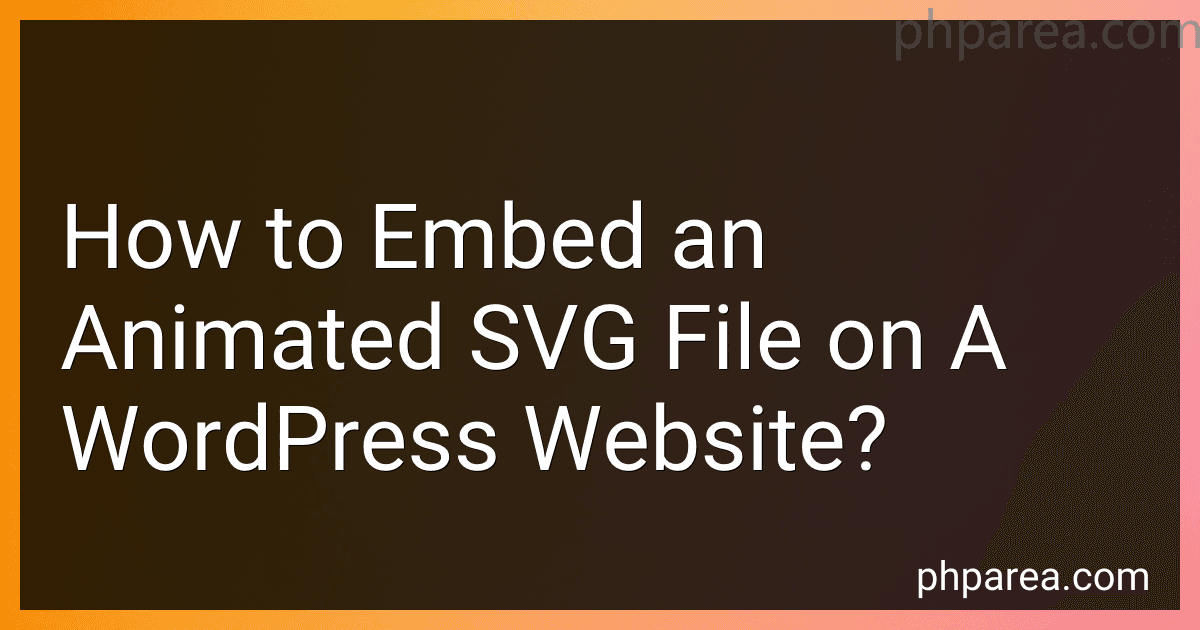Best Tools for SVG Animation to Buy in December 2025

Adobe Animate Classroom in a Book (2021 release)



Adobe Animate CC Classroom in a Book (2018 release)



Adobe Animate Classroom in a Book (2020 release)



Cricut Tools, Weeding Kit
- FIVE ESSENTIAL WEEDING TOOLS FOR EFFORTLESS VINYL CRAFTING.
- ENJOY FAST, EASY WEEDING FOR A FUN CREATIVE EXPERIENCE.
- PRECISION TOOLS FOR ACCURATE CUTS AND MAXIMUM COMFORT.


To embed an animated SVG file on a WordPress website, you can follow these steps:
- Convert your SVG file to an animated SVG (SVG animation) using an animation software or code.
- Open the WordPress dashboard and navigate to the page or post where you want to embed the animated SVG.
- In the visual editor, switch to the Text or Code editor mode.
- Locate the desired section or area where you want to add the animated SVG.
- Insert the HTML code for embedding the animated SVG. The code typically looks like this:
Replace <!-- SVG code for the animated SVG --> with the actual code for your animated SVG. 6. Save or update the page/post to apply the changes. 7. Preview the page or visit your website to see the animated SVG in action.
Remember to ensure that your animated SVG code is valid and compatible with WordPress. Sometimes certain CSS or JavaScript animations may not work as expected due to conflicts with the WordPress theme or plugins. In such cases, you might need to troubleshoot or seek assistance from a developer to resolve the issues.
How to animate individual elements within an SVG?
To animate individual elements within an SVG (Scalable Vector Graphics), you can use CSS or JavaScript. Here's an outline of the steps to animate SVG elements:
- Determine the SVG element you want to animate: Identify the specific element within the SVG that you wish to animate. Each element in the SVG should have an id attribute or a class so that you can reference it later for animation.
- Using CSS animation: Create a CSS animation: Write CSS animation keyframes using @keyframes rule to define the animation sequence. Apply the animation to the SVG element: Use the animation property in CSS to apply the animation to the SVG element. Specify the animation name, duration, timing function, delay, etc.
- Using JavaScript: Select the SVG element: Use JavaScript to select the desired SVG element using its id or class. Set animation properties: Use JavaScript to modify the element's attributes or styles over time to achieve the desired animation effect. This can be done using setInterval, setTimeout, or by using a library like GreenSock (GSAP) for more advanced animations.
Remember to check browser compatibility for the CSS properties or JavaScript methods you decide to use. Also, provide fallbacks or alternative solutions for browsers that do not support SVG animations using modern techniques like feature detection or progressive enhancement.
What is the recommended way to backup animated SVG files?
The recommended way to backup animated SVG files is by creating regular backups of the files themselves. Here are a few methods to consider:
- Manual backups: Make copies of your animated SVG files and store them on an external hard drive, USB drive, or another secure storage medium. This can be done manually by copying and pasting the files to the backup location.
- Cloud storage: Utilize cloud storage services like Google Drive, Dropbox, or Microsoft OneDrive to store your animated SVG files. Upload the files to your cloud account, and they will be accessible from any device connected to the internet. These services often have built-in backup and version control features, helping to protect your files.
- Version control system: Employ a version control system like Git or Mercurial to keep track of changes made to your animated SVG files. These systems allow you to maintain a history of file revisions and retrieve previous versions if needed.
- Automated backup software: Make use of backup software programs that can automatically back up your animated SVG files. These tools can be configured to create scheduled backups, ensuring your files are regularly and consistently saved to a secure storage location.
Regardless of the backup method you choose, it is important to ensure that the backups are stored securely and in a separate location from the original files. This safeguards against data loss due to hardware failure, accidental deletion, or other unforeseen events.
What is the maximum file size limit for an animated SVG on WordPress?
The maximum file size limit for an animated SVG on WordPress can vary depending on the hosting provider and server settings. Typically, most hosting providers have a default maximum file size limit of 2MB to 8MB. However, it is recommended to check with your specific hosting provider or server administrator to determine the exact file size limit for animated SVGs on your WordPress website.
What are the best practices for optimizing SVG animations for SEO?
Optimizing SVG animations for SEO (Search Engine Optimization) involves several best practices to ensure search engines can understand and rank your content appropriately. Here are some tips:
- Use descriptive filenames: Choose meaningful and descriptive names for your SVG animation files. This can help search engines identify and index your content more effectively.
- Include relevant keywords: Integrate relevant keywords related to your SVG animation within the surrounding page content. This will provide additional context for search engines to understand and rank your animation.
- Provide textual descriptions: Accompany your SVG animation with descriptive text. Use alt text to describe the animation in a concise and meaningful manner. This can help search engines comprehend the content and improve accessibility for users with disabilities.
- Utilize schema markup: Implement schema markup to provide structured data about your SVG animations. This can help search engines better understand the purpose and context of your animations, potentially leading to enhanced visibility in search results.
- Optimize page load speed: SVG animations, if not optimized properly, can increase page load times, affecting user experience and SEO. Minimize file size, compress images, and use caching techniques to optimize the load speed of your pages.
- Responsive design: Ensure your SVG animations are responsive and compatible with different screen sizes and devices. Responsive design is rewarded by search engines and can improve your overall SEO performance.
- Build high-quality backlinks: Promote your SVG animations by obtaining high-quality backlinks from reputable websites. Backlinks from authoritative sources can improve your website's visibility and domain authority, positively impacting your SEO efforts.
Remember, while optimizing SVG animations for SEO is important, it's equally crucial to prioritize the user experience and ensure your animations contribute positively to the overall user engagement and satisfaction on your website.
How to manually embed an animated SVG in a WordPress post?
To manually embed an animated SVG in a WordPress post, follow these steps:
- Edit the post in WordPress: Go to your WordPress dashboard, find the post you want to edit, and click on "Edit".
- Copy the SVG code: Open the SVG file in a text editor or SVG editor and copy the entire SVG code.
- Switch to the Text editor: In the WordPress post editor, switch from the Visual editor to the Text editor. This allows you to directly edit the HTML code.
- Paste the SVG code: Find the spot where you want to embed the SVG in the post and paste the SVG code directly into the Text editor.
- Save and Preview: Click on "Update" or "Publish" to save the changes to your post. Then, click on "Preview" to see how the animated SVG looks on your website.
Note: Depending on your theme or any customization plugins you have installed, the animated SVG might not display correctly. In that case, you may need to apply additional CSS or JavaScript to fix any issues.
